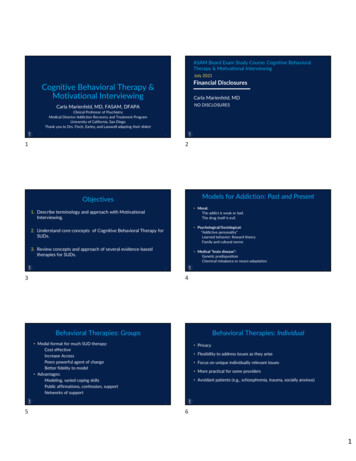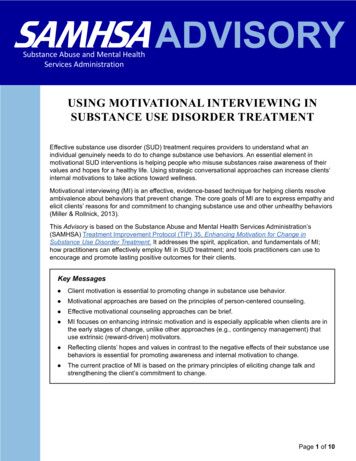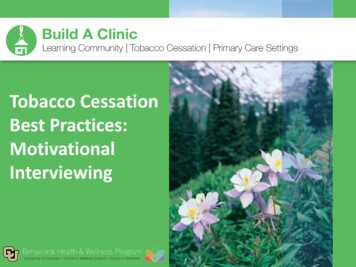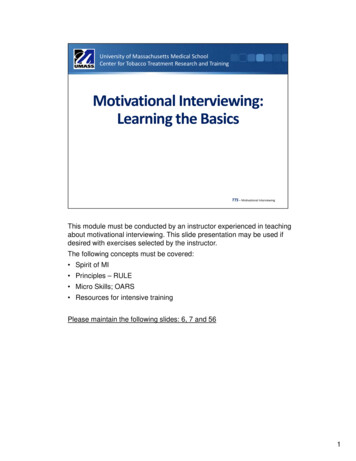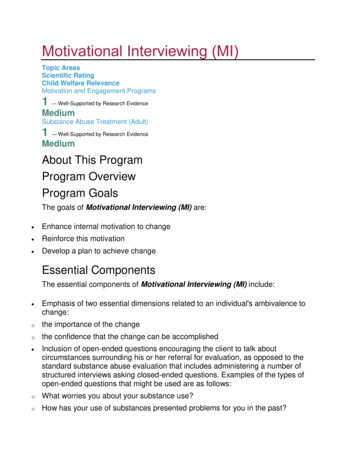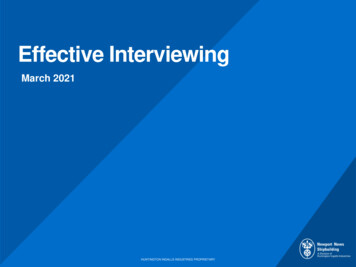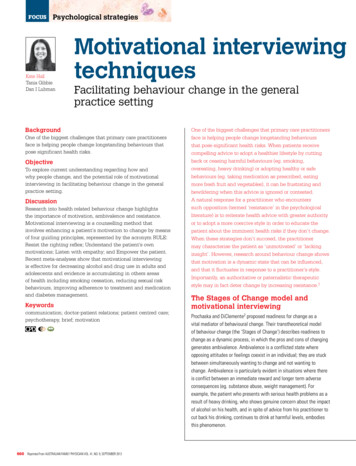
Transcription
Psychological strategiesKate HallTania GibbieDan I LubmanMotivational interviewingtechniquesFacilitating behaviour change in the generalpractice settingBackgroundOne of the biggest challenges that primary care practitionersface is helping people change longstanding behaviours thatpose significant health risks.ObjectiveTo explore current understanding regarding how andwhy people change, and the potential role of motivationalinterviewing in facilitating behaviour change in the generalpractice setting.DiscussionResearch into health related behaviour change highlightsthe importance of motivation, ambivalence and resistance.Motivational interviewing is a counselling method thatinvolves enhancing a patient’s motivation to change by meansof four guiding principles, represented by the acronym RULE:Resist the righting reflex; Understand the patient’s ownmotivations; Listen with empathy; and Empower the patient.Recent meta-analyses show that motivational interviewingis effective for decreasing alcohol and drug use in adults andadolescents and evidence is accumulating in others areasof health including smoking cessation, reducing sexual riskbehaviours, improving adherence to treatment and medicationand diabetes management.Keywordscommunication; doctor-patient relations; patient centred care;psychotherapy, brief; motivation660 Reprinted From Australian Family Physician Vol. 41, No. 9, september 2012One of the biggest challenges that primary care practitionersface is helping people change longstanding behavioursthat pose significant health risks. When patients receivecompelling advice to adopt a healthier lifestyle by cuttingback or ceasing harmful behaviours (eg. smoking,overeating, heavy drinking) or adopting healthy or safebehaviours (eg. taking medication as prescribed, eatingmore fresh fruit and vegetables), it can be frustrating andbewildering when this advice is ignored or contested.A natural response for a practitioner who encounterssuch opposition (termed ‘resistance’ in the psychologicalliterature) is to reiterate health advice with greater authorityor to adopt a more coercive style in order to educate thepatient about the imminent health risks if they don’t change.When these strategies don’t succeed, the practitionermay characterise the patient as ‘unmotivated’ or ‘lackinginsight’. However, research around behaviour change showsthat motivation is a dynamic state that can be influenced,and that it fluctuates in response to a practitioner’s style.Importantly, an authoritative or paternalistic therapeuticstyle may in fact deter change by increasing resistance.1The Stages of Change model andmotivational interviewingProchaska and DiClemente2 proposed readiness for change as avital mediator of behavioural change. Their transtheoretical modelof behaviour change (the ‘Stages of Change’) describes readiness tochange as a dynamic process, in which the pros and cons of changinggenerates ambivalence. Ambivalence is a conflicted state whereopposing attitudes or feelings coexist in an individual; they are stuckbetween simultaneously wanting to change and not wanting tochange. Ambivalence is particularly evident in situations where thereis conflict between an immediate reward and longer term adverseconsequences (eg. substance abuse, weight management). Forexample, the patient who presents with serious health problems as aresult of heavy drinking, who shows genuine concern about the impactof alcohol on his health, and in spite of advice from his practitioner tocut back his drinking, continues to drink at harmful levels, embodiesthis phenomenon.
The Prochaska and DiClemente Stages of Change model2 offers aconceptual framework for understanding the incremental processesthat people pass through as they change a particular behaviour. Thischange process is modelled in five parts as a progression from aninitial precontemplative stage, where the individual is not consideringchange; to a contemplative stage, where the individual is activelyambivalent about change; to preparation, where the individualbegins to plan and commit to change. Successful progression throughthese stages leads to action, where the necessary steps to achievechange are undertaken. If successful, action leads to the final stage,maintenance, where the person works to maintain and sustain longterm change.3 Relapse is considered an important stage in the changeprocess and is used as an opportunity to learn about sustainingmaintenance in the future.Motivational interviewing (MI) is an effective counselling methodthat enhances motivation through the resolution of ambivalence. Itgrew out of the Prochaska and DiClemente model described above2and Miller and Rollnick’s1 work in the field of addiction medicine,which drew on the phrase ‘ready, willing and able’ to outline threecritical components of motivation. These were:1 the importance of change for the patient (willingness) the confidence to change (ability) whether change is an immediate priority (readiness).Using MI techniques, the practitioner can tailor motivationalstrategies to the individual’s stage of change according to theProchaska and DiClemente model (Table 1).1,2Applications and effectiveness ofmotivational interviewingRecent meta-analyses show that MI is equivalent to or betterthan other treatments such as cognitive behavioural therapy (CBT)or pharmacotherapy, and superior to placebo and nontreatmentcontrols for decreasing alcohol and drug use in adults4–6 andadolescents.7 Motivational interviewing has also been shown to beefficacious in a number of other health conditions, such as smokingcessation,8 reducing sexual risk behaviours,9–11 improving adherenceto treatment and medication,12 as well as diabetes management.13In addition, studies support the applicability of MI to HIV care,such as improving adherence to antiretroviral therapy14,15 and thereduction of substance use among HIV positive men and women.15As such, MI is an important therapeutic technique that has wideapplicability within healthcare settings in motivating people tochange. In general practice, possible applications include: medication adherence management of the SNAP (smoking, nutrition, alcohol andphysical activity)16 risk factors engagement in prevention or management programs for diabetesor cardiovascular health management of substance abuse problems management of problem gambling or sexual risk taking pain managementTable 1. Practitioner tasks within the Stages ofChange model1,2Patient stagePractitioner tasksPrecontemplation(Not ready)Raise doubt and increase thepatient’s perception of the risksand problems with their currentbehaviour. Provide harm reductionstrategiesContemplation(Getting ready)Weigh up the pros and cons ofchange with the patient and workon helping them tip the balance by: exploring ambivalence andalternatives identifying reasons for change/risks of not changing increasing the patient’sconfidence in their ability tochangePreparation –action(Ready)Clear goal setting – help the patientto develop a realistic plan formaking a change and to take stepstoward changeMaintenance(Sticking to it)Help the patient to identify and usestrategies to prevent relapseRelapse*(Learning)Help the patient renew theprocesses of contemplation andaction without becoming stuck ordemoralised* Relapse is normalised in MI and is used as anopportunity to learn about how to maintain long termbehaviour change in the future stress management completion of recommended screening or diagnostic tests orspecialist/allied health/psychologist referral.The spirit of motivational interviewingMotivational interviewing is underpinned by a series of principlesthat emphasise a collaborative therapeutic relationship in whichthe autonomy of the patient is respected and the patient’sintrinsic resources for change are elicited by the therapist.Within MI, the therapist is viewed as a facilitator rather thanexpert, who adopts a nonconfrontational approach to guidethe patient toward change. The overall spirit of MI has beendescribed as collaborative, evocative and honouring of patientautonomy.1 Miller and Rollnick1 have commented that the useof MI strategies in the absence of the spirit of MI is ineffective.Although paradoxical, the MI approach is effective at engagingapparently ‘unmotivated’ individuals and when considered inthe context of standard practice can be a powerful engagementstrategy (Case study, Table 2).Reprinted From Australian Family Physician Vol. 41, No. 9, september 2012 661
FOCUS Motivational interviewing techniques – facilitating behaviour change in the general practice settingCase study – using the spirit ofmotivational interviewingA male patient, 52 years of age, who drinks heavily and hasexpressed the desire to reduce drinking, but continues todrink heavily.It is easy to conclude that this patient lacks motivation, hisjudgment is impaired or he simply does not understandthe effects of alcohol on his health. These conclusionsmay naturally lead the practitioner to adopt a paternalistictherapeutic style and warn the patient of the risks to hishealth. In subsequent consultations, when these strategiesdon’t work, it is easy to give up hope that he will changehis drinking, characterise him as ‘unmotivated’ and dropthe subject altogether. In MI, the opposite approach istaken, where the patient’s motivation is targeted by thepractitioner. Using the spirit of MI, the practitioner avoidsan authoritarian stance, and respects the autonomy ofthe patient by accepting he has the responsibility tochange his drinking – or not. Motivational interviewingemphasises eliciting reasons for change from the patient,rather than advising them of the reasons why they shouldchange their drinking. What concerns does he have aboutthe effects of his drinking? What future goals or personalvalues are impacted by his drinking? The apparent ‘lackof motivation’ evident in the patient would be constructedas ‘unresolved ambivalence’ within an MI framework. Thepractitioner would therefore work on understanding thisambivalence, by exploring the pros and cons of continuingto drink alcohol. They would then work on resolving thisambivalence, by connecting the things the patient caresabout with motivation for change. For example, drinkingmay impact the patient’s values about being a lovingpartner and father or being healthy and strong. A discussionof how continuing to drink (maintaining the status quo)will impact his future goals to travel in retirement or have agood relationship with his children may be the focus. Thepractitioner would emphasise that the decision to changeis ‘up to him’, however they would work with the patient toincrease his confidence that he can change (self efficacy).Motivational interviewing in practiceThe practical application of MI occurs in two phases: buildingmotivation to change, and strengthening commitment to change.Building motivation to changeIn Phase I, four early methods represented by the acronym OARS(Table 3) constitute the basic skills of MI. These basic counsellingtechniques assist in building rapport and establishing a therapeuticrelationship that is consistent with the spirit of MI.Strengthening commitment to changeThis involves goal setting and negotiating a ‘change plan of action’.In the absence of a goal directed approach, the application of thestrategies or spirit of MI can result in the maintenance of ambivalence,where patients and practitioners remain stuck. This trap can beavoided by employing strategies to elicit ‘change talk’.1 There are manystrategies to elicit ‘change talk’, but the simplest and most direct wayis to elicit a patient’s intention to change by asking a series of targetedquestions from the following four categories: disadvantages of the status quo advantages of change optimism for change and intention to change (Table 4).Alternatively, if a practitioner is time poor, a quick method of drawingout ‘change talk’ is to use an ‘importance ruler’.Example: ‘If you can think of a scale from zero to 10 of howimportant it is for you to lose weight. On this scale, zero is notimportant at all and 10 is extremely important. Where would you be onthis scale? Why are you at and not zero? What would it take foryou to go from to (a higher number)?’This technique identifies the discrepancy for a patient betweentheir current situation and where they would like to be. Highlightingthis discrepancy is at the core of motivating people to change. Thiscan be followed by asking the patient to elaborate further on thisdiscrepancy and then succinctly summarising this discrepancy andreflecting it back to the patient. Next, it is important to build theTable 2. The spirit of motivational interviewing vs an authoritative or paternalistic therapeutic styleThe spirit of motivational interviewingAuthoritative or paternalistic therapeutic styleCollaboration: a partnership between the patient andpractitioner is formed. Joint decision making occurs. Thepractitioner acknowledges the patient’s expertise aboutthemselvesConfrontation: the practitioner assumes the patient hasan impaired perspective and consequently imposes theneed for ‘insight’. The practitioner tries to persuade andcoerce a patient to changeEvocation: the practitioner activates the patient’s ownmotivation for change by evoking their reasons for change.The practitioner connects health behaviour change to thethings the patient cares aboutEducation: the patient is presumed to lack the insight,knowledge or skills required to change. The practitionertells the patient what to doHonouring a patient’s autonomy: although the practitionerinforms and advises their patient, they acknowledge thepatient’s right and freedom not to change. ‘It’s up to you’Authority: the practitioner instructs the patient to makechangesAdapted from Miller and Rollnick, 2002662 Reprinted From Australian Family Physician Vol. 41, No. 9, september 2012
Motivational interviewing techniques – facilitating behaviour change in the general practice setting FOCUSTable 3. OARS: The basic skills of motivational interviewingAsk Open-ended questions* The patient does most of the talking Gives the practitioner the opportunity to learn moreabout what the patient cares about (eg. their valuesand goals)ExampleI understand you have some concerns about your drinking.Can you tell me about them?VersusAre you concerned about your drinking?Make Affirmations Can take the form of compliments or statements ofappreciation and understanding Helps build rapport and validate and support thepatient during the process of change Most effective when the patient’s strengths andefforts for change are noticed and affirmedExampleI appreciate that it took a lot of courage for you to discussyour drinking with me todayYou appear to have a lot of resourcefulness to have copedwith these difficulties for the past few yearsThank you for hanging in there with me. I appreciate this isnot easy for you to hearUse Reflections* Involves rephrasing a statement to capture theimplicit meaning and feeling of a patient’s statement Encourages continual personal exploration and helpspeople understand their motivations more fully Can be used to amplify or reinforce desire for changeExampleYou enjoy the effects of alcohol in terms of how it helps youunwind after a stressful day at work and helps you interactwith friends without being too self-conscious. But you arebeginning to worry about the impact drinking is having onyour health. In fact, until recently you weren’t too worriedabout how much you drank because you thought you hadit under control. Then you found out your health has beenaffected and your partner said a few things that have madeyou doubt that alcohol is helping you at allUse Summarising Links discussions and ‘checks in’ with the patient Ensure mutual understanding of the discussion so far Point out discrepancies between the person’s currentsituation and future goals Demonstrates listening and understand the patient’sperspectiveExampleIf it is okay with you, just let me check that I understandeverything that we’ve been discussing so far. You have beenworrying about how much you’ve been drinking in recentmonths because you recognise that you have experiencedsome health issues associated with your alcohol intake, andyou’ve had some feedback from your partner that she isn’thappy with how much you’re drinking. But the few timesyou’ve tried to stop drinking have not been easy, and you areworried that you can’t stop. How am I doing?* A general rule-of-thumb in MI practice is to ask an open-ended question, followed by 2–3 reflectionspatient’s confidence in their ability to change. This involves focusingon the patient’s strengths and past experiences of success. Again, a‘confidence ruler’ could be employed if a practitioner is time poor.Example: ‘If you can think of a scale from zero to 10 of howconfident you are that you can cut back the amount you are drinking.On this scale, zero is not confident at all and 10 is extremely confident.Where would you be on this scale? Why are you at and not zero?What would it take for you to go from to (a higher number)?’Finally, decide on a ‘change plan’ together. This involves standardgoal setting techniques, using the spirit of MI as the guiding principle andeliciting from the patient what they plan to do (rather than instructing oradvising). If a practitioner feels that the patient needs health advice at thispoint in order to set appropriate goals, it is customary to ask permissionbefore giving advice as this honours the patient’s autonomy. Examples ofkey questions to build a ‘change plan’ include: It sounds like things can’t stay the same as they are. What do youthink you might do? What changes were you thinking about making? Where do we go from here? What do you want to do at this point? How would you like things to turn out? After reviewing all of this, what’s the next step for you?It is common for patients to ask for answers or ‘quick fixes’ duringPhase II. In keeping with the spirit of MI, a simple phrase reminding thepatient of their autonomy is useful, ‘You are the expert on you, so I’mnot sure I am the best person to judge what will work for you. But I cangive you an idea of what the evidence shows us and what other peoplehave done in your situation’.The guiding principles of motivationalinterviewingIn general practice, the particular difficulties associated with quickconsultation times can present unique challenges in implementing MI.Miller and Rollnick17 have attempted to simplify the practice of MI forhealth care settings by developing four guiding principles, representedby the acronym RULE:Reprinted From Australian Family Physician Vol. 41, No. 9, september 2012 663
Motivational interviewing techniques – facilitating behaviour change in the general practice setting FOCUSTable 4. Eliciting ‘change talk’1 Change talkQuestions to elicit change talkExample of patient’s change talkDisadvantages of thestatus quo What worries you about your bloodpressure? What difficulties have resulted from yourdrinking? In what way does your weight concernyou?‘I guess, if I’m honest, if I keep drinking,I am worried my family are going to stopforgiving me for my behaviour’Advantages of change How would you like your health to be in 5years time? What are the advantages of reducing yourdrinking? What would be different in your life if youlost weight?‘If I lose weight, at least I won’t have towake up feeling guilty every morning that Iam not taking care of myself’Optimism for change When have you made a significant changein your life before? How did you do it? What strengths do you have that wouldhelp you make a change?‘I did stop smoking a few years ago for ayear and I felt so much healthier. It wasreally hard, but once I put my mind tosomething I usually stick at it’Intention to change In what ways do you want your life to bedifferent in 5 years? Forget how you would get there for amoment. If you could do anything, whatwould you change?‘I never thought I would be living like this.I want to go back to being healthy andstrong, with enough energy to enjoy myfriends and family’. ‘I want to manage mydiabetes better’Resist the righting reflexUnderstand the patient’s own motivationsListen with empathyEmpower the patient.Resist the righting reflexThe righting reflex describes the tendency of health professionals toadvise patients about the right path for good health. This can often havea paradoxical effect in practice, inadvertently reinforcing the argumentto maintain the status quo. Essentially, most people resist persuasionwhen they are ambivalent about change and will respond by recallingtheir reasons for maintaining the behaviour. Motivational interviewing inpractice requires clinicians to suppress the initial righting reflex so thatthey can explore the patient’s motivations for change.Understand your patient’s motivationsIt is the patient’s own reasons for change, rather than the practitioner’s,that will ultimately result in behaviour change. By approaching apatient’s interests, concerns and values with curiosity and openlyexploring the patient’s motivations for change, the practitioner willbegin to get a better understanding of the patient’s motivations andpotential barriers to change.Listen with empathyEffective listening skills are essential to understand what will motivatethe patient, as well as the pros and cons of their situation. A generalrule-of-thumb in MI is that equal amounts of time in a consultationshould be spent listening and talking.Empower your patientPatient outcomes improve when they are an active collaborator in theirtreatment.17 Empowering patients involves exploring their own ideasabout how they can make changes to improve their health and drawingon the patient’s personal knowledge about what has succeeded inthe past. A truly collaborative therapeutic relationship is a powerfulmotivator. Patients benefit from this relationship the most when thepractitioner also embodies hope that change is possible.RULE is a useful mnemonic to draw upon when implementingthe spirit of MI in general practice. If a practitioner has more time,four additional principles (Table 5) can be applied within a longertherapeutic intervention.Barriers to implementing motivationalinterviewing in general practiceBarriers to implementing MI in general practice include time pressures,the professional development required in order to master MI, difficultyin adopting the spirit of MI when practitioners embody an expert role,patients’ overwhelming desire for ‘quick fix’ options to health issuesand the brevity of consultation times. These barriers to implementingMI in primary care represent significant cons on a decisional balance.On the other hand, the pros for adopting an MI approach with patientswho are resistant to change are compelling. While we are notadvocating MI for all patient interactions in general practice, we invitepractitioners to explore their own ambivalence toward adopting MIwithin their practice, and consider whether they are ‘willing, ready andable’. Practitioners who undertake MI training will have an additionaltherapeutic tool to draw upon when encountering patient resistanceReprinted From Australian Family Physician Vol. 41, No. 9, september 2012 665
FOCUS Motivational interviewing techniques – facilitating behaviour change in the general practice settingTable 5. Four further principles of motivational interviewingExpress empathyIn practical terms, an empathic style of communication involves the use of reflective listening skills and accurateempathy, where the practitioner seeks to understand the patient’s perspective, thoughts and feelings withoutjudgeing, criticising or blaming. Building empathy and understanding does not mean the practitioner condones theproblematic behaviour. Instead, the practitioner seeks to create an open and respectful exchange with the patient,who they approach with genuine curiosity about their experiences, feelings and valuesDevelop discrepancyAssisting patients to identify discrepancies between their current behaviour and future goals or values aboutthemselves as a person, partner, parent, or worker is a powerful motivator that helps ‘tip the balance’ toward change.Exploring the pros and cons of change can help a patient develop discrepancy. These ‘decisional balance’ exercisesare used effectively in MI to help patients tease apart their ambivalence and help the patient express their concernsabout the behaviourRoll with resistanceOften when a practitioner attempts to move a patient toward change too quickly because the risks of the behaviourare significant or they perceive that there are time pressures for change, they adopt a coercive or authoritative style.If the patient is ambivalent about change, this approach will commonly be met with resistance from the patient.Resistance takes many forms but most commonly can be described as interrupting or arguing with the practitioner,discounting the practitioner’s expertise, excusing their behaviour, minimising the effects of their behaviour, blamingother people for their behaviour, being pessimistic about their chances to change or being unwilling to changealtogether. In MI, rolling with this resistance involves approaching resistance without judgement and interpretingthese responses as a sign that the patient holds a different perspective to the practitioner. MI then uses strategiessuch as simple reflection of the resistance, emphasising the individual’s choice to change or not (‘it’s up to you’),shifting the focus of the discussion or simply reframing what the person has said, in order to roll with resistance andprevent resistance from affecting engagementSupport self efficacyMany people with enduring behaviours that have negative impacts on their health have made their own attempts tochange at some time or other and been unsuccessful. They may have attempted to cease smoking and only lasteda week, or tried to lose weight but been unable to sustain a diet. They may have attempted to comply with theirmedication several times in the past but found it difficult because of side effects or a complicated dosing regimen.By highlighting the patient’s strengths and reflecting on times in their life when they have successfully changed,even if just in one small area, self efficacy can be promoted. The practitioner’s belief in a patient’s ability to changeis a powerful way to promote self efficacy. By promoting self efficacy, the practitioner can help the individual developthe confidence that they are capable of changeto change and a proven method for dealing with a number of commonpresentations within general practice.ReferencesResource2.For further information and online motivational interviewing trainingopportunities visit www.motivationalinterview.org.1.3.AuthorsKate Hall BA(Hons), DPsych(Clin), MAPS, is Senior Lecturer, DeakinUniversity, Department of Psychology and senior clinical psychologist,Turning Point Alcohol and Drug Centre, Eastern Health, Melbourne,Victoria. kateh@turningpoint.org.auTania Gibbie BSc(Hons), MPsych(Health), PhD, is a health psychologist,Barwon Health, Geelong, VictoriaDan I Lubman BSc(Hons), MBChB, PhD, FRANZCP, FAChAM, is Directorand Professor of Addiction Studies, Turning Point Alcohol and DrugCentre, Eastern Health and Monash University, Melbourne, Victoria.Conflict of interest: none declared.666 Reprinted From Australian Family Physician Vol. 41, No. 9, september 20124.5.6.7.Miller WR, Rollnick S. Motivational Interviewing. Preparing peoplefor change. 2nd edn. New York: The Guilford Press, 2002.Prochaska J, DiClemente C. Towards a comprehensive model ofchange. In: Miller WR, Heather N, editors. Treating addictive behaviours: processes of change. New York: Pergamon, 1986.DiClemente CC, Velasquez M. Motivational interviewing and thestages of change. In: Miller WR, Rollnick S, editors. Motivationalinterviewing, second edition: Preparing people for change. NewYork: The Guilford Press, 2002.Burke BL, Arkowitz H, Menchola M. The efficacy of motivationalinterviewing: a meta-analysis of controlled trials. J Consult ClinPsychol 2003;71:843–61.Hettema J, Steele J, Miller WR. Motivational interviewing. AnnRev Clin Psychol 2005;1:91–111.Lundahl BW, Kunz C, Brownell C, Tollefson D, Burke BL. A metaanalysis of motivational interviewing: twenty-five years ofempirical studies. Res Soc Work Pract 2010;20:137–60.Jensen CD, Cushing CC, Aylward BS, Craig JT, Sorell DM, SteeleRG. Effectiveness of motivational interviewing interventions foradolescent substance use behavior change: a meta-analytic review.J Consult Clin Psychol 2011;79:433–40.
Motivational interviewing techniques – facilitating behaviour change in the general practice setting FOCUS8.9.10.11.12.13.14.15.16.17.Gray E, McCambridge J, Strang J. The effectiveness of motivationalinterviewing delivered by youth workers in reducing drinking, cigarette and cannabis smoking among young people: quasi-experimentalpilot study. Alcohol 2005;40:535–9.Fisher J, Fisher W, Cornman D, Amico R, Bryan A, Friedland G.Clinician-delivered intervention during routine clinical care reducesunprotected sexual behaviour among HIV-infected patients. J AcquirImmune Defic Syndr 2006;41:44–52.Kuyper L, de Wit J, Heijman T, Fennema H, van Bergen J,Vanwesenbeeck I. Influencing risk behavior of sexually transmitted infection clinic visitors: Efficacy of a new methodology ofmotivational preventive counseling. AIDS Patient Care STDs2009;23:423–31.Naar-King S, Wright K, Parsons J, et al. Healthy choices:Motivational enhancement therapy for health risk behaviours in HIVpositive youth. AIDS Educ Prev 2006;18:1–11.Swanson AJ, Pantalon MV, Cohen KR. Motivational interviewingand treatment adherence among psychiatric and dually diagnosedpatients. J Nerv Ment Dis 1999;187:630–5.West D, Dilillo V, Bursac Z, Gore SA, Greene PG. Motivationalinterviewing improves weight loss in women
Facilitating behaviour change in the general practice setting Background One of the biggest challenges that primary care practitioners face is helping people change longstanding behaviours that pose significant health risks. Objective To explore current understanding regarding how and why people change, and the potential role of motivational
